The Influence of Country-of-Origin on HRM in Singapore: An Essay
VerifiedAdded on 2020/04/13
|17
|3951
|67
Essay
AI Summary
This essay examines the extent to which the employment and HR practices of US-owned and Japanese-owned companies in Singapore are explained by their country-of-origin. It argues that cultural factors, economic systems, and government policies significantly influence HRM strategies. The essay highlights the differences in HR approaches between US and Japanese companies, focusing on aspects like employee relations, training, and compensation. It uses examples like Toyota and Apple to illustrate how these companies adapt their practices in Singapore, considering both global strategies and local contexts. The essay discusses staffing approaches, including ethnocentric, polycentric, and geocentric models, and explores the challenges of international HRM, such as adapting to local norms and managing compensation across different countries. The conclusion supports the idea that country-of-origin plays a crucial role in shaping HRM practices in Singapore, emphasizing the importance of understanding cultural and economic differences for effective international management.
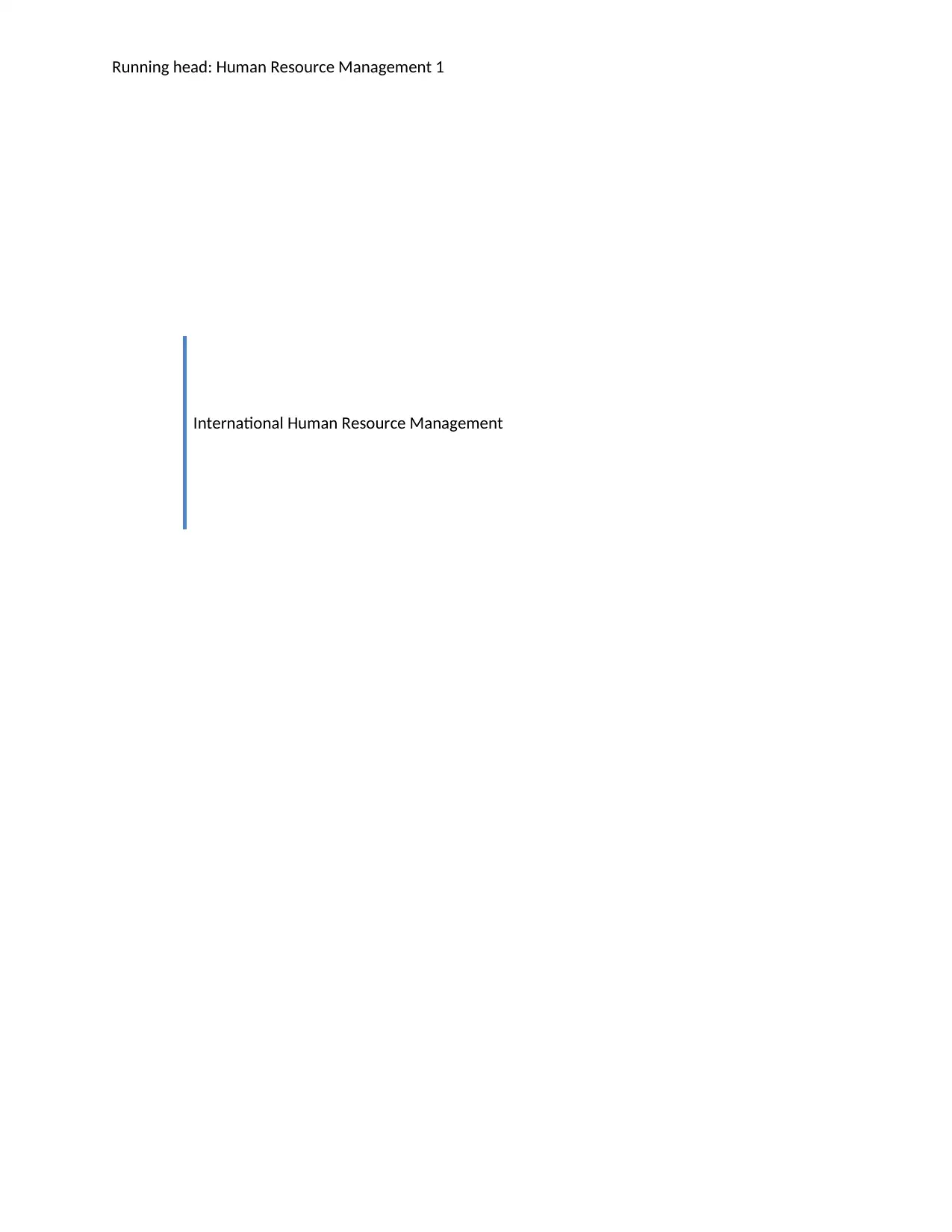
Running head: Human Resource Management 1
International Human Resource Management
International Human Resource Management
Paraphrase This Document
Need a fresh take? Get an instant paraphrase of this document with our AI Paraphraser
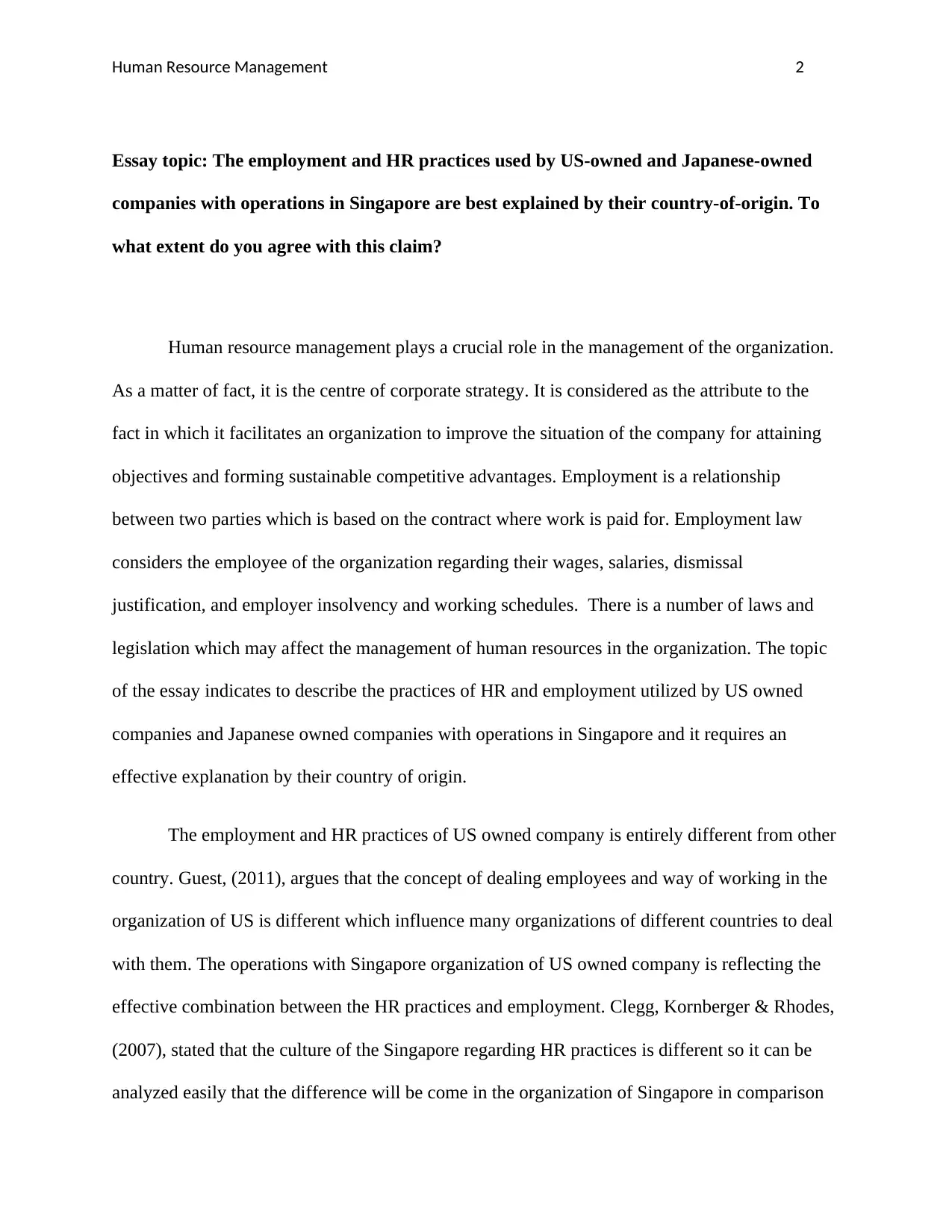
Human Resource Management 2
Essay topic: The employment and HR practices used by US-owned and Japanese-owned
companies with operations in Singapore are best explained by their country-of-origin. To
what extent do you agree with this claim?
Human resource management plays a crucial role in the management of the organization.
As a matter of fact, it is the centre of corporate strategy. It is considered as the attribute to the
fact in which it facilitates an organization to improve the situation of the company for attaining
objectives and forming sustainable competitive advantages. Employment is a relationship
between two parties which is based on the contract where work is paid for. Employment law
considers the employee of the organization regarding their wages, salaries, dismissal
justification, and employer insolvency and working schedules. There is a number of laws and
legislation which may affect the management of human resources in the organization. The topic
of the essay indicates to describe the practices of HR and employment utilized by US owned
companies and Japanese owned companies with operations in Singapore and it requires an
effective explanation by their country of origin.
The employment and HR practices of US owned company is entirely different from other
country. Guest, (2011), argues that the concept of dealing employees and way of working in the
organization of US is different which influence many organizations of different countries to deal
with them. The operations with Singapore organization of US owned company is reflecting the
effective combination between the HR practices and employment. Clegg, Kornberger & Rhodes,
(2007), stated that the culture of the Singapore regarding HR practices is different so it can be
analyzed easily that the difference will be come in the organization of Singapore in comparison
Essay topic: The employment and HR practices used by US-owned and Japanese-owned
companies with operations in Singapore are best explained by their country-of-origin. To
what extent do you agree with this claim?
Human resource management plays a crucial role in the management of the organization.
As a matter of fact, it is the centre of corporate strategy. It is considered as the attribute to the
fact in which it facilitates an organization to improve the situation of the company for attaining
objectives and forming sustainable competitive advantages. Employment is a relationship
between two parties which is based on the contract where work is paid for. Employment law
considers the employee of the organization regarding their wages, salaries, dismissal
justification, and employer insolvency and working schedules. There is a number of laws and
legislation which may affect the management of human resources in the organization. The topic
of the essay indicates to describe the practices of HR and employment utilized by US owned
companies and Japanese owned companies with operations in Singapore and it requires an
effective explanation by their country of origin.
The employment and HR practices of US owned company is entirely different from other
country. Guest, (2011), argues that the concept of dealing employees and way of working in the
organization of US is different which influence many organizations of different countries to deal
with them. The operations with Singapore organization of US owned company is reflecting the
effective combination between the HR practices and employment. Clegg, Kornberger & Rhodes,
(2007), stated that the culture of the Singapore regarding HR practices is different so it can be
analyzed easily that the difference will be come in the organization of Singapore in comparison
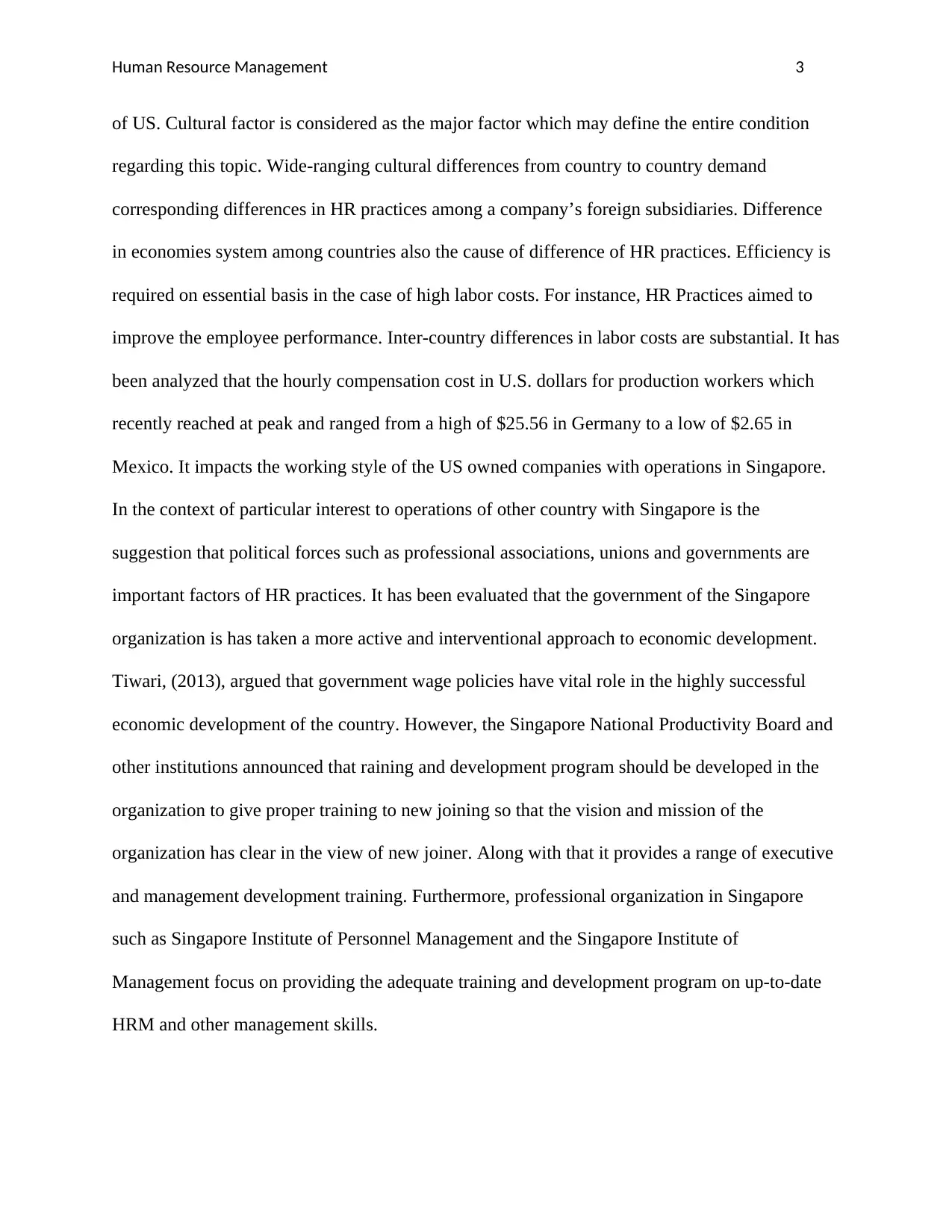
Human Resource Management 3
of US. Cultural factor is considered as the major factor which may define the entire condition
regarding this topic. Wide-ranging cultural differences from country to country demand
corresponding differences in HR practices among a company’s foreign subsidiaries. Difference
in economies system among countries also the cause of difference of HR practices. Efficiency is
required on essential basis in the case of high labor costs. For instance, HR Practices aimed to
improve the employee performance. Inter-country differences in labor costs are substantial. It has
been analyzed that the hourly compensation cost in U.S. dollars for production workers which
recently reached at peak and ranged from a high of $25.56 in Germany to a low of $2.65 in
Mexico. It impacts the working style of the US owned companies with operations in Singapore.
In the context of particular interest to operations of other country with Singapore is the
suggestion that political forces such as professional associations, unions and governments are
important factors of HR practices. It has been evaluated that the government of the Singapore
organization is has taken a more active and interventional approach to economic development.
Tiwari, (2013), argued that government wage policies have vital role in the highly successful
economic development of the country. However, the Singapore National Productivity Board and
other institutions announced that raining and development program should be developed in the
organization to give proper training to new joining so that the vision and mission of the
organization has clear in the view of new joiner. Along with that it provides a range of executive
and management development training. Furthermore, professional organization in Singapore
such as Singapore Institute of Personnel Management and the Singapore Institute of
Management focus on providing the adequate training and development program on up-to-date
HRM and other management skills.
of US. Cultural factor is considered as the major factor which may define the entire condition
regarding this topic. Wide-ranging cultural differences from country to country demand
corresponding differences in HR practices among a company’s foreign subsidiaries. Difference
in economies system among countries also the cause of difference of HR practices. Efficiency is
required on essential basis in the case of high labor costs. For instance, HR Practices aimed to
improve the employee performance. Inter-country differences in labor costs are substantial. It has
been analyzed that the hourly compensation cost in U.S. dollars for production workers which
recently reached at peak and ranged from a high of $25.56 in Germany to a low of $2.65 in
Mexico. It impacts the working style of the US owned companies with operations in Singapore.
In the context of particular interest to operations of other country with Singapore is the
suggestion that political forces such as professional associations, unions and governments are
important factors of HR practices. It has been evaluated that the government of the Singapore
organization is has taken a more active and interventional approach to economic development.
Tiwari, (2013), argued that government wage policies have vital role in the highly successful
economic development of the country. However, the Singapore National Productivity Board and
other institutions announced that raining and development program should be developed in the
organization to give proper training to new joining so that the vision and mission of the
organization has clear in the view of new joiner. Along with that it provides a range of executive
and management development training. Furthermore, professional organization in Singapore
such as Singapore Institute of Personnel Management and the Singapore Institute of
Management focus on providing the adequate training and development program on up-to-date
HRM and other management skills.
⊘ This is a preview!⊘
Do you want full access?
Subscribe today to unlock all pages.

Trusted by 1+ million students worldwide
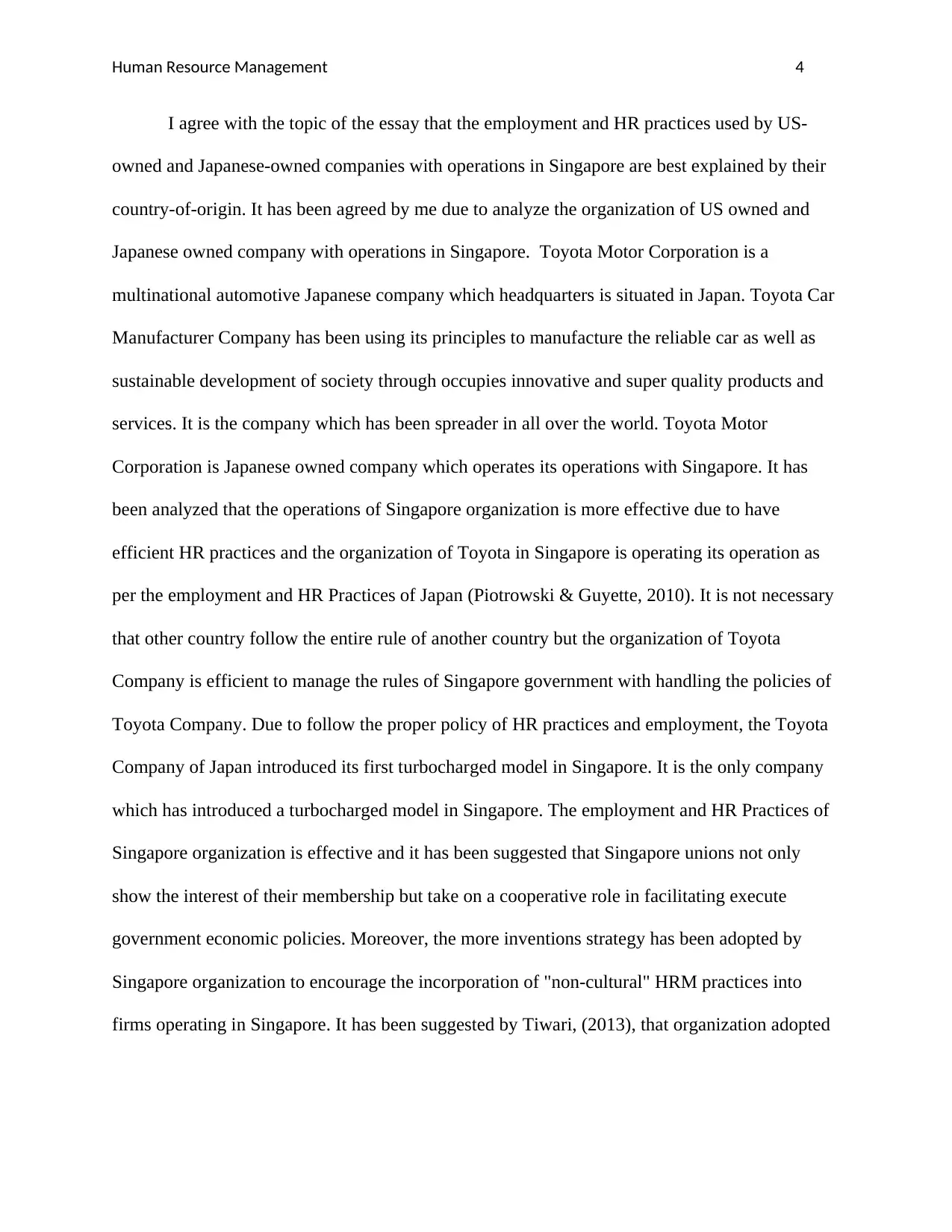
Human Resource Management 4
I agree with the topic of the essay that the employment and HR practices used by US-
owned and Japanese-owned companies with operations in Singapore are best explained by their
country-of-origin. It has been agreed by me due to analyze the organization of US owned and
Japanese owned company with operations in Singapore. Toyota Motor Corporation is a
multinational automotive Japanese company which headquarters is situated in Japan. Toyota Car
Manufacturer Company has been using its principles to manufacture the reliable car as well as
sustainable development of society through occupies innovative and super quality products and
services. It is the company which has been spreader in all over the world. Toyota Motor
Corporation is Japanese owned company which operates its operations with Singapore. It has
been analyzed that the operations of Singapore organization is more effective due to have
efficient HR practices and the organization of Toyota in Singapore is operating its operation as
per the employment and HR Practices of Japan (Piotrowski & Guyette, 2010). It is not necessary
that other country follow the entire rule of another country but the organization of Toyota
Company is efficient to manage the rules of Singapore government with handling the policies of
Toyota Company. Due to follow the proper policy of HR practices and employment, the Toyota
Company of Japan introduced its first turbocharged model in Singapore. It is the only company
which has introduced a turbocharged model in Singapore. The employment and HR Practices of
Singapore organization is effective and it has been suggested that Singapore unions not only
show the interest of their membership but take on a cooperative role in facilitating execute
government economic policies. Moreover, the more inventions strategy has been adopted by
Singapore organization to encourage the incorporation of "non-cultural" HRM practices into
firms operating in Singapore. It has been suggested by Tiwari, (2013), that organization adopted
I agree with the topic of the essay that the employment and HR practices used by US-
owned and Japanese-owned companies with operations in Singapore are best explained by their
country-of-origin. It has been agreed by me due to analyze the organization of US owned and
Japanese owned company with operations in Singapore. Toyota Motor Corporation is a
multinational automotive Japanese company which headquarters is situated in Japan. Toyota Car
Manufacturer Company has been using its principles to manufacture the reliable car as well as
sustainable development of society through occupies innovative and super quality products and
services. It is the company which has been spreader in all over the world. Toyota Motor
Corporation is Japanese owned company which operates its operations with Singapore. It has
been analyzed that the operations of Singapore organization is more effective due to have
efficient HR practices and the organization of Toyota in Singapore is operating its operation as
per the employment and HR Practices of Japan (Piotrowski & Guyette, 2010). It is not necessary
that other country follow the entire rule of another country but the organization of Toyota
Company is efficient to manage the rules of Singapore government with handling the policies of
Toyota Company. Due to follow the proper policy of HR practices and employment, the Toyota
Company of Japan introduced its first turbocharged model in Singapore. It is the only company
which has introduced a turbocharged model in Singapore. The employment and HR Practices of
Singapore organization is effective and it has been suggested that Singapore unions not only
show the interest of their membership but take on a cooperative role in facilitating execute
government economic policies. Moreover, the more inventions strategy has been adopted by
Singapore organization to encourage the incorporation of "non-cultural" HRM practices into
firms operating in Singapore. It has been suggested by Tiwari, (2013), that organization adopted
Paraphrase This Document
Need a fresh take? Get an instant paraphrase of this document with our AI Paraphraser
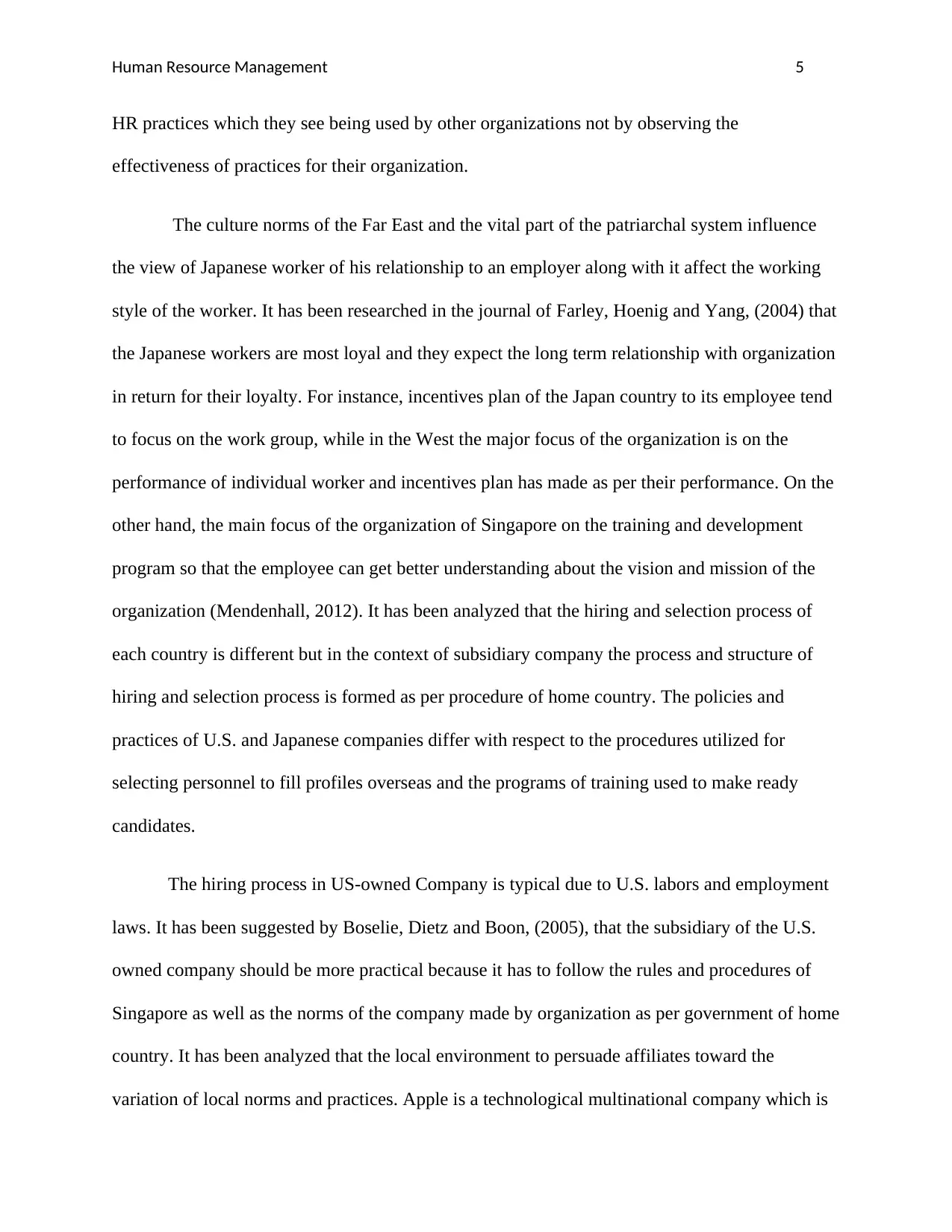
Human Resource Management 5
HR practices which they see being used by other organizations not by observing the
effectiveness of practices for their organization.
The culture norms of the Far East and the vital part of the patriarchal system influence
the view of Japanese worker of his relationship to an employer along with it affect the working
style of the worker. It has been researched in the journal of Farley, Hoenig and Yang, (2004) that
the Japanese workers are most loyal and they expect the long term relationship with organization
in return for their loyalty. For instance, incentives plan of the Japan country to its employee tend
to focus on the work group, while in the West the major focus of the organization is on the
performance of individual worker and incentives plan has made as per their performance. On the
other hand, the main focus of the organization of Singapore on the training and development
program so that the employee can get better understanding about the vision and mission of the
organization (Mendenhall, 2012). It has been analyzed that the hiring and selection process of
each country is different but in the context of subsidiary company the process and structure of
hiring and selection process is formed as per procedure of home country. The policies and
practices of U.S. and Japanese companies differ with respect to the procedures utilized for
selecting personnel to fill profiles overseas and the programs of training used to make ready
candidates.
The hiring process in US-owned Company is typical due to U.S. labors and employment
laws. It has been suggested by Boselie, Dietz and Boon, (2005), that the subsidiary of the U.S.
owned company should be more practical because it has to follow the rules and procedures of
Singapore as well as the norms of the company made by organization as per government of home
country. It has been analyzed that the local environment to persuade affiliates toward the
variation of local norms and practices. Apple is a technological multinational company which is
HR practices which they see being used by other organizations not by observing the
effectiveness of practices for their organization.
The culture norms of the Far East and the vital part of the patriarchal system influence
the view of Japanese worker of his relationship to an employer along with it affect the working
style of the worker. It has been researched in the journal of Farley, Hoenig and Yang, (2004) that
the Japanese workers are most loyal and they expect the long term relationship with organization
in return for their loyalty. For instance, incentives plan of the Japan country to its employee tend
to focus on the work group, while in the West the major focus of the organization is on the
performance of individual worker and incentives plan has made as per their performance. On the
other hand, the main focus of the organization of Singapore on the training and development
program so that the employee can get better understanding about the vision and mission of the
organization (Mendenhall, 2012). It has been analyzed that the hiring and selection process of
each country is different but in the context of subsidiary company the process and structure of
hiring and selection process is formed as per procedure of home country. The policies and
practices of U.S. and Japanese companies differ with respect to the procedures utilized for
selecting personnel to fill profiles overseas and the programs of training used to make ready
candidates.
The hiring process in US-owned Company is typical due to U.S. labors and employment
laws. It has been suggested by Boselie, Dietz and Boon, (2005), that the subsidiary of the U.S.
owned company should be more practical because it has to follow the rules and procedures of
Singapore as well as the norms of the company made by organization as per government of home
country. It has been analyzed that the local environment to persuade affiliates toward the
variation of local norms and practices. Apple is a technological multinational company which is
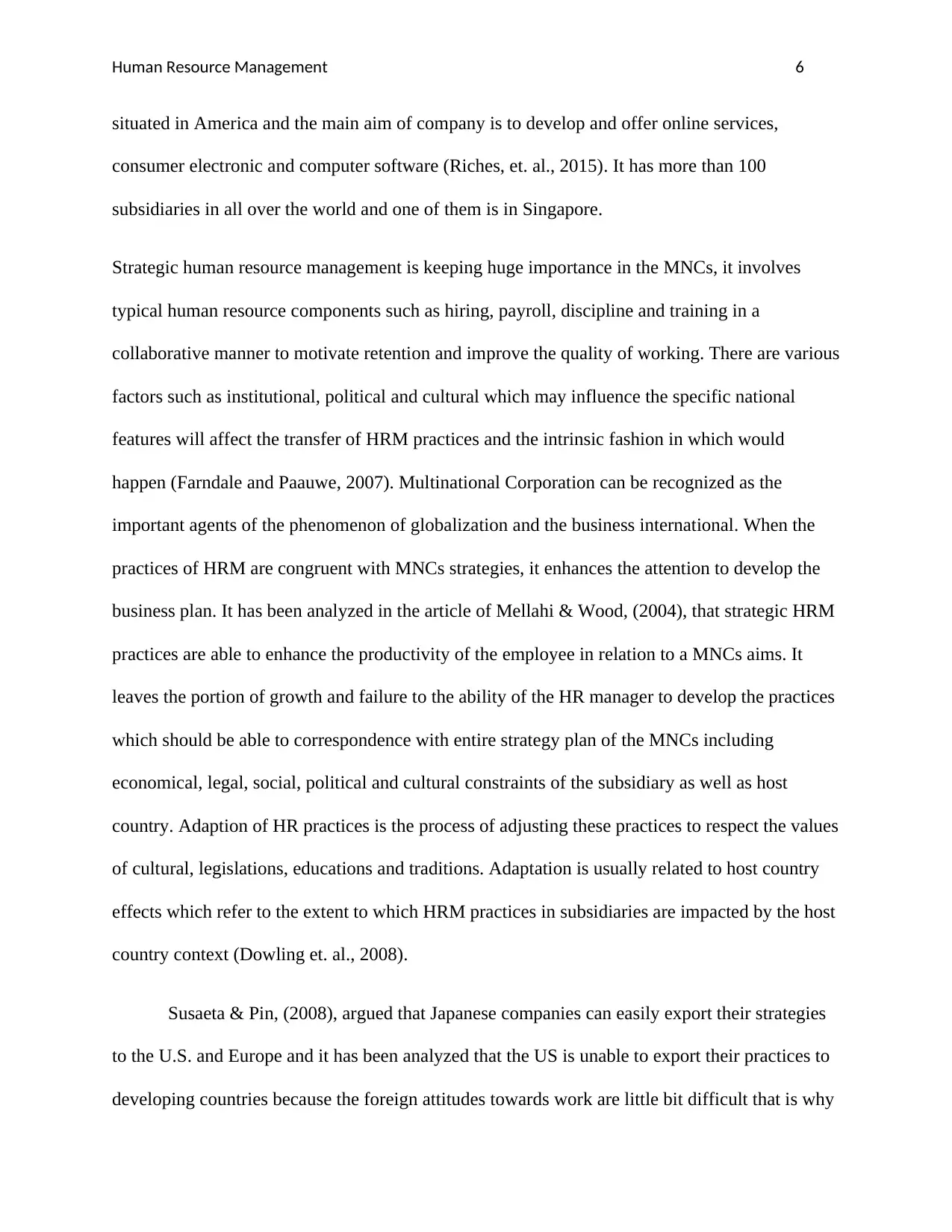
Human Resource Management 6
situated in America and the main aim of company is to develop and offer online services,
consumer electronic and computer software (Riches, et. al., 2015). It has more than 100
subsidiaries in all over the world and one of them is in Singapore.
Strategic human resource management is keeping huge importance in the MNCs, it involves
typical human resource components such as hiring, payroll, discipline and training in a
collaborative manner to motivate retention and improve the quality of working. There are various
factors such as institutional, political and cultural which may influence the specific national
features will affect the transfer of HRM practices and the intrinsic fashion in which would
happen (Farndale and Paauwe, 2007). Multinational Corporation can be recognized as the
important agents of the phenomenon of globalization and the business international. When the
practices of HRM are congruent with MNCs strategies, it enhances the attention to develop the
business plan. It has been analyzed in the article of Mellahi & Wood, (2004), that strategic HRM
practices are able to enhance the productivity of the employee in relation to a MNCs aims. It
leaves the portion of growth and failure to the ability of the HR manager to develop the practices
which should be able to correspondence with entire strategy plan of the MNCs including
economical, legal, social, political and cultural constraints of the subsidiary as well as host
country. Adaption of HR practices is the process of adjusting these practices to respect the values
of cultural, legislations, educations and traditions. Adaptation is usually related to host country
effects which refer to the extent to which HRM practices in subsidiaries are impacted by the host
country context (Dowling et. al., 2008).
Susaeta & Pin, (2008), argued that Japanese companies can easily export their strategies
to the U.S. and Europe and it has been analyzed that the US is unable to export their practices to
developing countries because the foreign attitudes towards work are little bit difficult that is why
situated in America and the main aim of company is to develop and offer online services,
consumer electronic and computer software (Riches, et. al., 2015). It has more than 100
subsidiaries in all over the world and one of them is in Singapore.
Strategic human resource management is keeping huge importance in the MNCs, it involves
typical human resource components such as hiring, payroll, discipline and training in a
collaborative manner to motivate retention and improve the quality of working. There are various
factors such as institutional, political and cultural which may influence the specific national
features will affect the transfer of HRM practices and the intrinsic fashion in which would
happen (Farndale and Paauwe, 2007). Multinational Corporation can be recognized as the
important agents of the phenomenon of globalization and the business international. When the
practices of HRM are congruent with MNCs strategies, it enhances the attention to develop the
business plan. It has been analyzed in the article of Mellahi & Wood, (2004), that strategic HRM
practices are able to enhance the productivity of the employee in relation to a MNCs aims. It
leaves the portion of growth and failure to the ability of the HR manager to develop the practices
which should be able to correspondence with entire strategy plan of the MNCs including
economical, legal, social, political and cultural constraints of the subsidiary as well as host
country. Adaption of HR practices is the process of adjusting these practices to respect the values
of cultural, legislations, educations and traditions. Adaptation is usually related to host country
effects which refer to the extent to which HRM practices in subsidiaries are impacted by the host
country context (Dowling et. al., 2008).
Susaeta & Pin, (2008), argued that Japanese companies can easily export their strategies
to the U.S. and Europe and it has been analyzed that the US is unable to export their practices to
developing countries because the foreign attitudes towards work are little bit difficult that is why
⊘ This is a preview!⊘
Do you want full access?
Subscribe today to unlock all pages.

Trusted by 1+ million students worldwide
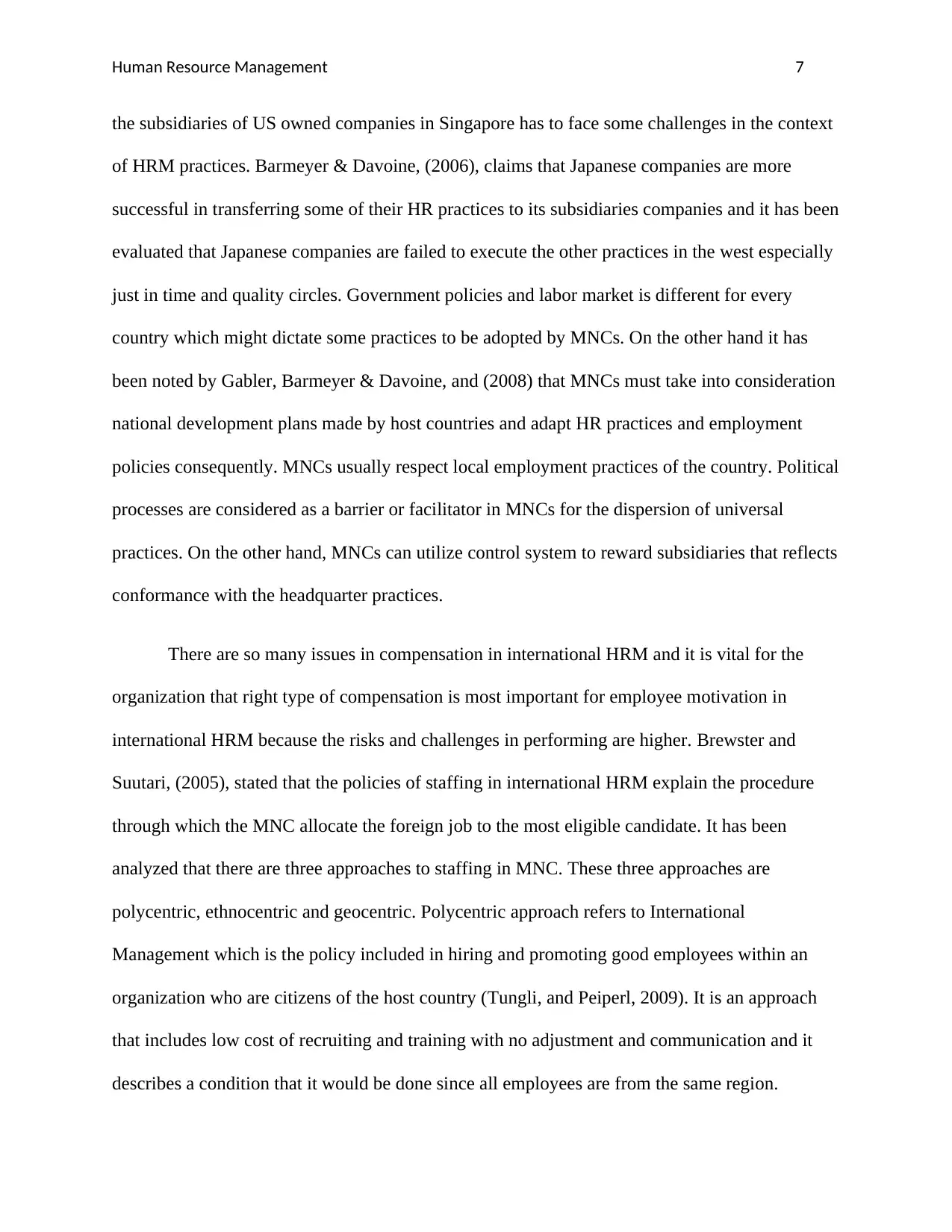
Human Resource Management 7
the subsidiaries of US owned companies in Singapore has to face some challenges in the context
of HRM practices. Barmeyer & Davoine, (2006), claims that Japanese companies are more
successful in transferring some of their HR practices to its subsidiaries companies and it has been
evaluated that Japanese companies are failed to execute the other practices in the west especially
just in time and quality circles. Government policies and labor market is different for every
country which might dictate some practices to be adopted by MNCs. On the other hand it has
been noted by Gabler, Barmeyer & Davoine, and (2008) that MNCs must take into consideration
national development plans made by host countries and adapt HR practices and employment
policies consequently. MNCs usually respect local employment practices of the country. Political
processes are considered as a barrier or facilitator in MNCs for the dispersion of universal
practices. On the other hand, MNCs can utilize control system to reward subsidiaries that reflects
conformance with the headquarter practices.
There are so many issues in compensation in international HRM and it is vital for the
organization that right type of compensation is most important for employee motivation in
international HRM because the risks and challenges in performing are higher. Brewster and
Suutari, (2005), stated that the policies of staffing in international HRM explain the procedure
through which the MNC allocate the foreign job to the most eligible candidate. It has been
analyzed that there are three approaches to staffing in MNC. These three approaches are
polycentric, ethnocentric and geocentric. Polycentric approach refers to International
Management which is the policy included in hiring and promoting good employees within an
organization who are citizens of the host country (Tungli, and Peiperl, 2009). It is an approach
that includes low cost of recruiting and training with no adjustment and communication and it
describes a condition that it would be done since all employees are from the same region.
the subsidiaries of US owned companies in Singapore has to face some challenges in the context
of HRM practices. Barmeyer & Davoine, (2006), claims that Japanese companies are more
successful in transferring some of their HR practices to its subsidiaries companies and it has been
evaluated that Japanese companies are failed to execute the other practices in the west especially
just in time and quality circles. Government policies and labor market is different for every
country which might dictate some practices to be adopted by MNCs. On the other hand it has
been noted by Gabler, Barmeyer & Davoine, and (2008) that MNCs must take into consideration
national development plans made by host countries and adapt HR practices and employment
policies consequently. MNCs usually respect local employment practices of the country. Political
processes are considered as a barrier or facilitator in MNCs for the dispersion of universal
practices. On the other hand, MNCs can utilize control system to reward subsidiaries that reflects
conformance with the headquarter practices.
There are so many issues in compensation in international HRM and it is vital for the
organization that right type of compensation is most important for employee motivation in
international HRM because the risks and challenges in performing are higher. Brewster and
Suutari, (2005), stated that the policies of staffing in international HRM explain the procedure
through which the MNC allocate the foreign job to the most eligible candidate. It has been
analyzed that there are three approaches to staffing in MNC. These three approaches are
polycentric, ethnocentric and geocentric. Polycentric approach refers to International
Management which is the policy included in hiring and promoting good employees within an
organization who are citizens of the host country (Tungli, and Peiperl, 2009). It is an approach
that includes low cost of recruiting and training with no adjustment and communication and it
describes a condition that it would be done since all employees are from the same region.
Paraphrase This Document
Need a fresh take? Get an instant paraphrase of this document with our AI Paraphraser
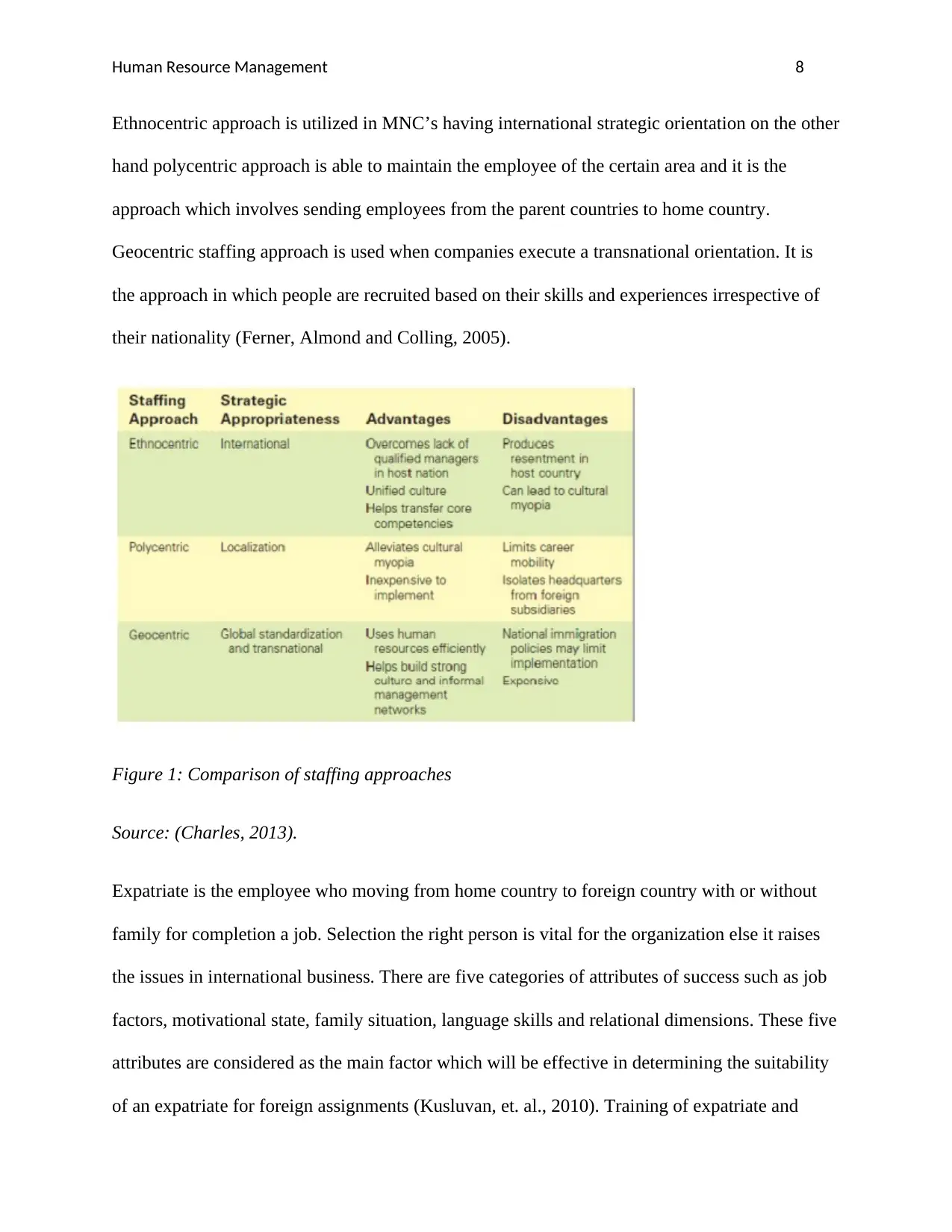
Human Resource Management 8
Ethnocentric approach is utilized in MNC’s having international strategic orientation on the other
hand polycentric approach is able to maintain the employee of the certain area and it is the
approach which involves sending employees from the parent countries to home country.
Geocentric staffing approach is used when companies execute a transnational orientation. It is
the approach in which people are recruited based on their skills and experiences irrespective of
their nationality (Ferner, Almond and Colling, 2005).
Figure 1: Comparison of staffing approaches
Source: (Charles, 2013).
Expatriate is the employee who moving from home country to foreign country with or without
family for completion a job. Selection the right person is vital for the organization else it raises
the issues in international business. There are five categories of attributes of success such as job
factors, motivational state, family situation, language skills and relational dimensions. These five
attributes are considered as the main factor which will be effective in determining the suitability
of an expatriate for foreign assignments (Kusluvan, et. al., 2010). Training of expatriate and
Ethnocentric approach is utilized in MNC’s having international strategic orientation on the other
hand polycentric approach is able to maintain the employee of the certain area and it is the
approach which involves sending employees from the parent countries to home country.
Geocentric staffing approach is used when companies execute a transnational orientation. It is
the approach in which people are recruited based on their skills and experiences irrespective of
their nationality (Ferner, Almond and Colling, 2005).
Figure 1: Comparison of staffing approaches
Source: (Charles, 2013).
Expatriate is the employee who moving from home country to foreign country with or without
family for completion a job. Selection the right person is vital for the organization else it raises
the issues in international business. There are five categories of attributes of success such as job
factors, motivational state, family situation, language skills and relational dimensions. These five
attributes are considered as the main factor which will be effective in determining the suitability
of an expatriate for foreign assignments (Kusluvan, et. al., 2010). Training of expatriate and
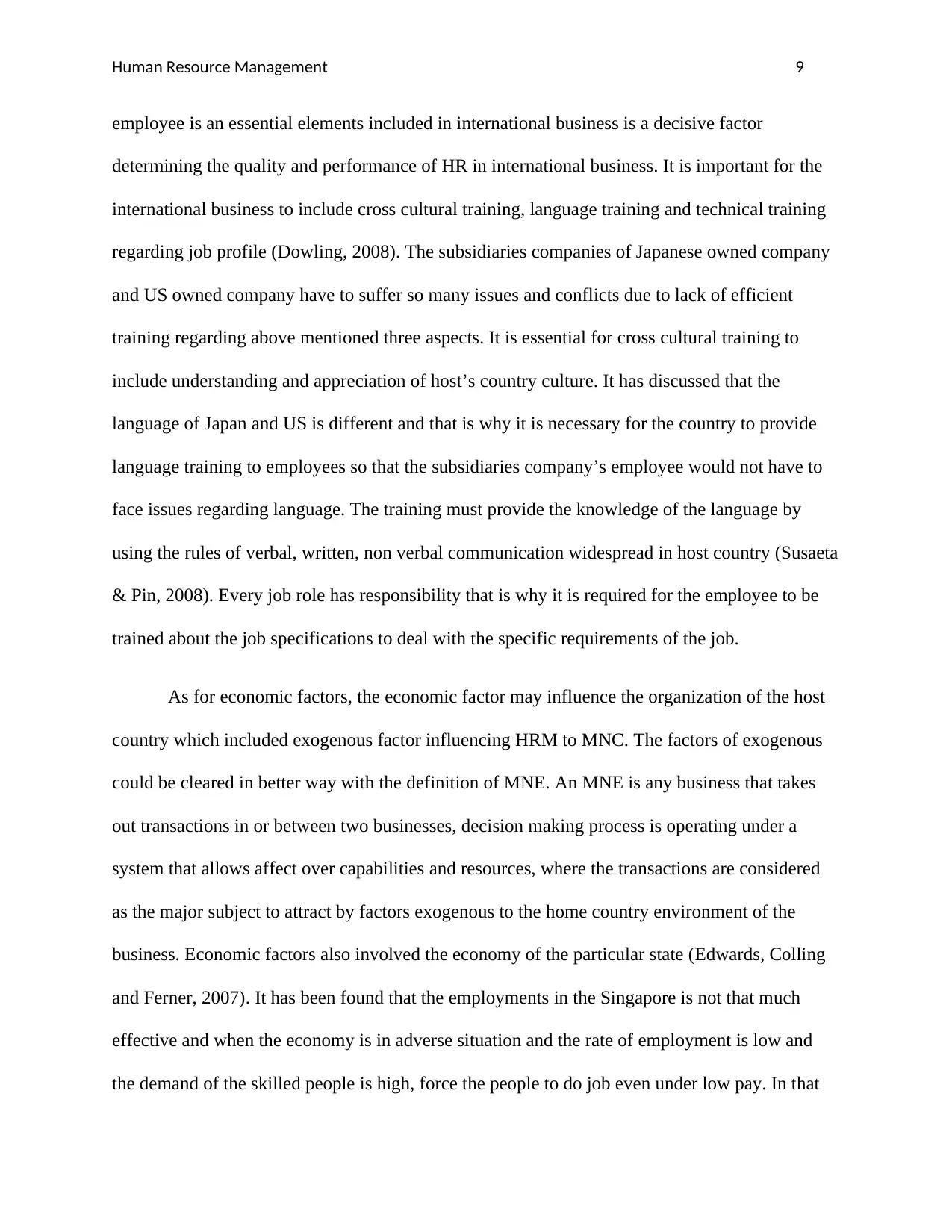
Human Resource Management 9
employee is an essential elements included in international business is a decisive factor
determining the quality and performance of HR in international business. It is important for the
international business to include cross cultural training, language training and technical training
regarding job profile (Dowling, 2008). The subsidiaries companies of Japanese owned company
and US owned company have to suffer so many issues and conflicts due to lack of efficient
training regarding above mentioned three aspects. It is essential for cross cultural training to
include understanding and appreciation of host’s country culture. It has discussed that the
language of Japan and US is different and that is why it is necessary for the country to provide
language training to employees so that the subsidiaries company’s employee would not have to
face issues regarding language. The training must provide the knowledge of the language by
using the rules of verbal, written, non verbal communication widespread in host country (Susaeta
& Pin, 2008). Every job role has responsibility that is why it is required for the employee to be
trained about the job specifications to deal with the specific requirements of the job.
As for economic factors, the economic factor may influence the organization of the host
country which included exogenous factor influencing HRM to MNC. The factors of exogenous
could be cleared in better way with the definition of MNE. An MNE is any business that takes
out transactions in or between two businesses, decision making process is operating under a
system that allows affect over capabilities and resources, where the transactions are considered
as the major subject to attract by factors exogenous to the home country environment of the
business. Economic factors also involved the economy of the particular state (Edwards, Colling
and Ferner, 2007). It has been found that the employments in the Singapore is not that much
effective and when the economy is in adverse situation and the rate of employment is low and
the demand of the skilled people is high, force the people to do job even under low pay. In that
employee is an essential elements included in international business is a decisive factor
determining the quality and performance of HR in international business. It is important for the
international business to include cross cultural training, language training and technical training
regarding job profile (Dowling, 2008). The subsidiaries companies of Japanese owned company
and US owned company have to suffer so many issues and conflicts due to lack of efficient
training regarding above mentioned three aspects. It is essential for cross cultural training to
include understanding and appreciation of host’s country culture. It has discussed that the
language of Japan and US is different and that is why it is necessary for the country to provide
language training to employees so that the subsidiaries company’s employee would not have to
face issues regarding language. The training must provide the knowledge of the language by
using the rules of verbal, written, non verbal communication widespread in host country (Susaeta
& Pin, 2008). Every job role has responsibility that is why it is required for the employee to be
trained about the job specifications to deal with the specific requirements of the job.
As for economic factors, the economic factor may influence the organization of the host
country which included exogenous factor influencing HRM to MNC. The factors of exogenous
could be cleared in better way with the definition of MNE. An MNE is any business that takes
out transactions in or between two businesses, decision making process is operating under a
system that allows affect over capabilities and resources, where the transactions are considered
as the major subject to attract by factors exogenous to the home country environment of the
business. Economic factors also involved the economy of the particular state (Edwards, Colling
and Ferner, 2007). It has been found that the employments in the Singapore is not that much
effective and when the economy is in adverse situation and the rate of employment is low and
the demand of the skilled people is high, force the people to do job even under low pay. In that
⊘ This is a preview!⊘
Do you want full access?
Subscribe today to unlock all pages.

Trusted by 1+ million students worldwide
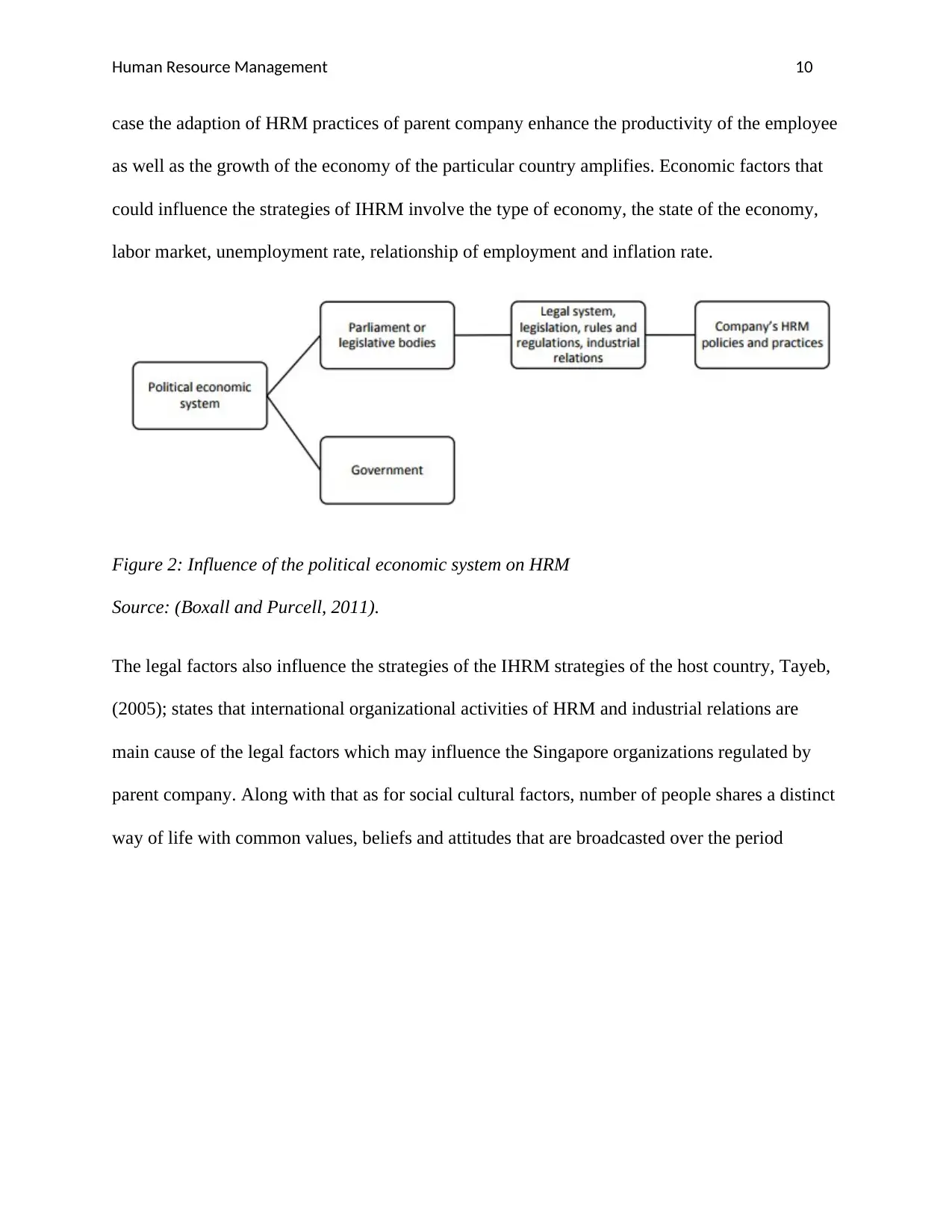
Human Resource Management 10
case the adaption of HRM practices of parent company enhance the productivity of the employee
as well as the growth of the economy of the particular country amplifies. Economic factors that
could influence the strategies of IHRM involve the type of economy, the state of the economy,
labor market, unemployment rate, relationship of employment and inflation rate.
Figure 2: Influence of the political economic system on HRM
Source: (Boxall and Purcell, 2011).
The legal factors also influence the strategies of the IHRM strategies of the host country, Tayeb,
(2005); states that international organizational activities of HRM and industrial relations are
main cause of the legal factors which may influence the Singapore organizations regulated by
parent company. Along with that as for social cultural factors, number of people shares a distinct
way of life with common values, beliefs and attitudes that are broadcasted over the period
case the adaption of HRM practices of parent company enhance the productivity of the employee
as well as the growth of the economy of the particular country amplifies. Economic factors that
could influence the strategies of IHRM involve the type of economy, the state of the economy,
labor market, unemployment rate, relationship of employment and inflation rate.
Figure 2: Influence of the political economic system on HRM
Source: (Boxall and Purcell, 2011).
The legal factors also influence the strategies of the IHRM strategies of the host country, Tayeb,
(2005); states that international organizational activities of HRM and industrial relations are
main cause of the legal factors which may influence the Singapore organizations regulated by
parent company. Along with that as for social cultural factors, number of people shares a distinct
way of life with common values, beliefs and attitudes that are broadcasted over the period
Paraphrase This Document
Need a fresh take? Get an instant paraphrase of this document with our AI Paraphraser
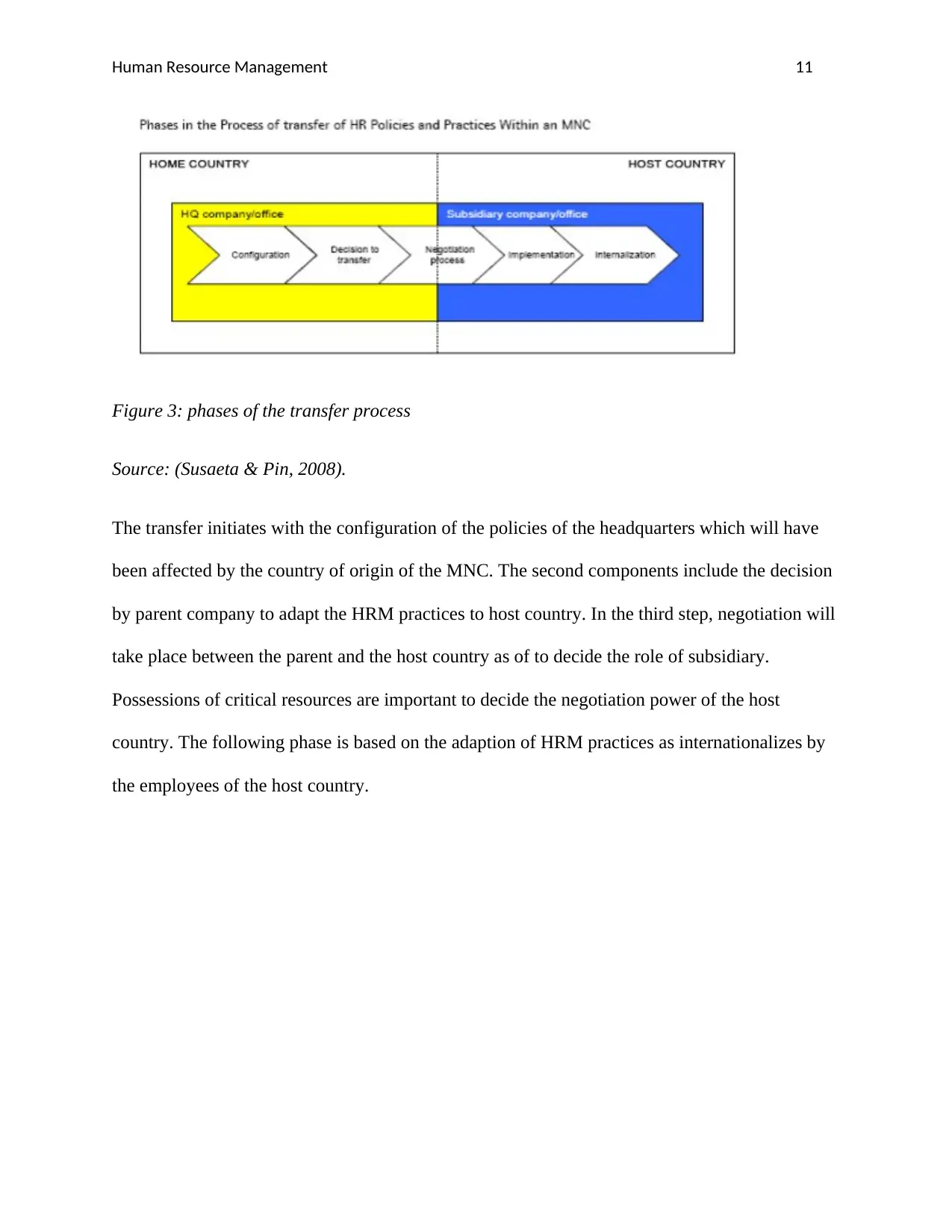
Human Resource Management 11
Figure 3: phases of the transfer process
Source: (Susaeta & Pin, 2008).
The transfer initiates with the configuration of the policies of the headquarters which will have
been affected by the country of origin of the MNC. The second components include the decision
by parent company to adapt the HRM practices to host country. In the third step, negotiation will
take place between the parent and the host country as of to decide the role of subsidiary.
Possessions of critical resources are important to decide the negotiation power of the host
country. The following phase is based on the adaption of HRM practices as internationalizes by
the employees of the host country.
Figure 3: phases of the transfer process
Source: (Susaeta & Pin, 2008).
The transfer initiates with the configuration of the policies of the headquarters which will have
been affected by the country of origin of the MNC. The second components include the decision
by parent company to adapt the HRM practices to host country. In the third step, negotiation will
take place between the parent and the host country as of to decide the role of subsidiary.
Possessions of critical resources are important to decide the negotiation power of the host
country. The following phase is based on the adaption of HRM practices as internationalizes by
the employees of the host country.
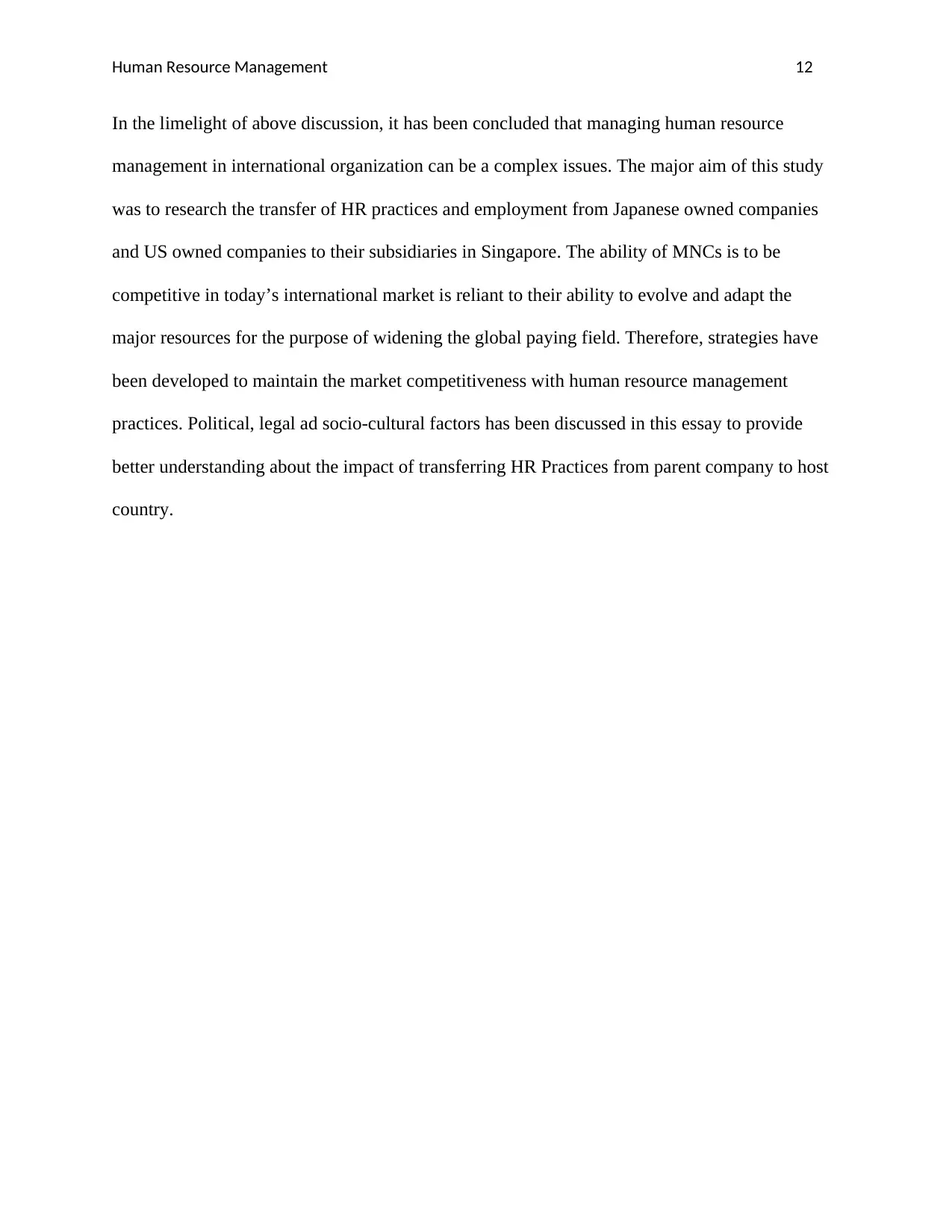
Human Resource Management 12
In the limelight of above discussion, it has been concluded that managing human resource
management in international organization can be a complex issues. The major aim of this study
was to research the transfer of HR practices and employment from Japanese owned companies
and US owned companies to their subsidiaries in Singapore. The ability of MNCs is to be
competitive in today’s international market is reliant to their ability to evolve and adapt the
major resources for the purpose of widening the global paying field. Therefore, strategies have
been developed to maintain the market competitiveness with human resource management
practices. Political, legal ad socio-cultural factors has been discussed in this essay to provide
better understanding about the impact of transferring HR Practices from parent company to host
country.
In the limelight of above discussion, it has been concluded that managing human resource
management in international organization can be a complex issues. The major aim of this study
was to research the transfer of HR practices and employment from Japanese owned companies
and US owned companies to their subsidiaries in Singapore. The ability of MNCs is to be
competitive in today’s international market is reliant to their ability to evolve and adapt the
major resources for the purpose of widening the global paying field. Therefore, strategies have
been developed to maintain the market competitiveness with human resource management
practices. Political, legal ad socio-cultural factors has been discussed in this essay to provide
better understanding about the impact of transferring HR Practices from parent company to host
country.
⊘ This is a preview!⊘
Do you want full access?
Subscribe today to unlock all pages.

Trusted by 1+ million students worldwide
1 out of 17
Related Documents
Your All-in-One AI-Powered Toolkit for Academic Success.
+13062052269
info@desklib.com
Available 24*7 on WhatsApp / Email
![[object Object]](/_next/static/media/star-bottom.7253800d.svg)
Unlock your academic potential
Copyright © 2020–2025 A2Z Services. All Rights Reserved. Developed and managed by ZUCOL.




